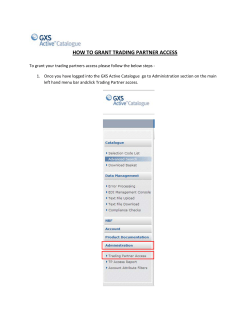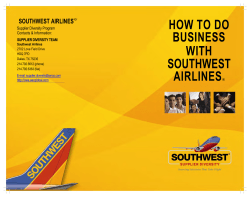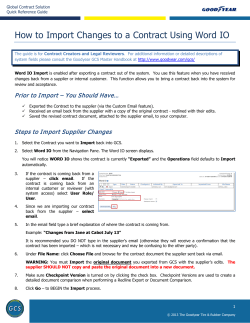
Sourcing and Contracts Chapter 14 1 utdallas.edu/~metin
Sourcing and Contracts
Chapter 14
1
utdallas.edu/~metin
Outline
The
Role of Sourcing in a Supply Chain
Supplier Scoring and Assessment
Supplier Selection and Contracts
Design Collaboration
The Procurement Process
Sourcing Planning and Analysis
Making Sourcing Decisions in Practice
Summary of Learning Objectives
2
utdallas.edu/~metin
The Role of Sourcing in a Supply Chain
Sourcing is the set of business processes required to
purchase goods and services
Sourcing processes include:
–
–
–
–
–
Supplier scoring and assessment
Supplier selection and contract negotiation
Design collaboration
Procurement
Sourcing planning and analysis
3
utdallas.edu/~metin
Benefits of Effective Sourcing Decisions
Better economies of scale can be achieved if orders are aggregated
– Eliminate some suppliers. Keep strategic dual sourcing.
» DineEquity Inc., Glendale, CA, parent company of IHOP and Applebee's
restaurants, is consolidating the vendors the two restaurant chains use -- and,
in the process, is getting a discount by buying more from the vendors it does
keep. DineEquity purchased Applebee's in 2007 and found that there was
75% overlap among IHOP's and Applebee's vendors.
More efficient procurement transactions can significantly reduce the overall
cost of purchasing
– Buying commodities from commodity exchanges / internet sites
– Firms can achieve a lower purchase price by increasing competition through the use of
auctions
Design collaboration can result in products that are easier to manufacture and
distribute, resulting in lower overall costs
– Ford sends its own engineers to its suppliers
Appropriate supplier contracts can allow for the sharing of risk
– Buyback contract redistributes the risk of overstocking
4
utdallas.edu/~metin
Supplier Scoring and Assessment
Supplier performance should be compared on the basis of the supplier’s impact
on total cost
There are several other factors besides purchase price that influence total cost
Replenishment Lead Time
On-Time Performance
Supply Flexibility
Delivery Frequency / Minimum
Lot Size
Supply Quality
Inbound Transportation Cost
Pricing Terms
Information Coordination
Capability
Design Collaboration
Capability
Exchange Rates, Taxes, Duties
Supplier Viability
5
utdallas.edu/~metin
Example of Supplier Assessment
I am currently sourcing out a multi-carrier shipping system for my
company. Since I'll be locked into whatever choice I make for the
next 4-5 years, I want to make sure I choose wisely. Do you have
any comments on the following: Clippership, Pitney Bowes,
NextShip, Logicor, Pfastship, or any others that you may currently
be using? By the way, over 80% of our shipping is small carrier
(UPS, FedEx, USPS), and the remainder is LTL. I am interested in
your comments concerning reliability, tech support, and customer
support.
– Steve Bachman. April 29, 2006 e-mailed to SupplyChainManagement@yahoogroups.com
6
utdallas.edu/~metin
Example of Transporter Assessments
Hello friends,
My project tile is "Transporter rating system“ under this project I have to the
parameters for rating [transporters].
- Rahul Gaikwad. April 28, 2007 e-mailed to SupplyChainManagement@yahoogroups.com
You can measure transporter performance in the following ways:
1) Cost effectiveness (Affordability)
2) Delivery speed
3) Damage rate (%)
4) Quantity flexibility
5) Time flexibility ( based on your need transport availability)
6)Assurity (how safe & secure your goods is reaching to the destination)
- Austin Lowrie. April 29, 2007 e-mailed to SupplyChainManagement@yahoogroups.com
7
utdallas.edu/~metin
Example: UTD Procurement – Department
Bidding requirements as of Nov 14, 2008
UTD is a State of Texas agency and required by state law to bid out orders and give
opportunities to companies and HUBS (Historically Underutilized Business) whenever
possible. If you have an expensive or technical purchase please contact us at the beginning
of the process if the cost exceeds $10,000.
We can write an RFP (Request for Proposal) and send out a BID for your [UTD personnel]
product and service now, allowing you [UTD personnel] to evaluate and discuss the
proposals legally with the vendors. As a team we will pick the “Best Value” solution.
–
If you do this with out our involvement and then send us a purchase requisition we may have to formally bid
out your order, delaying your project. Only a state certified buyer can legally “bid” on behalf of the University.
http://www.utsystem.edu/policy/policies/uts156.html
Federal Funds: http://www.whitehouse.gov/omb/circulars/index-education.html Positive
efforts shall be made by [fund] recipients to utilize small businesses, minority-owned
firms, and women's business enterprises, whenever possible. Recipients shall, on request,
make available for the Federal awarding agency, pre-award review and procurement
documents, such as request for proposals or invitations for bids, independent cost
estimates, etc., when any of the following conditions apply.
– A recipient's procurement procedures or operation fails to comply with the procurement standards
in the Federal awarding agency's implementation of this Circular.
– The procurement is expected to exceed the small purchase threshold fixed at 41 U.S.C. 403 (11)
(currently $25,000) and is to be awarded without competition or only one bid or offer is received
in response to a solicitation.
– The procurement, which is expected to exceed the small purchase threshold, specifies a "brand
8
name" product.
utdallas.edu/~metin
Example: UTD Procurement
All procurement transactions shall be conducted in a manner to provide, to the
maximum extent practical, open and free competition.
– < $10,000: we can purchase with one or more quotes at Purchasing’s discretion.
– >10,000 and < $25,000: we require at least 3 informal bids, with two HUB
Historically Underutilized Businesses, from the CMBL bidders list run by the
State of Texas www2.cpa.state.tx.us/cmbl/cmblhub.html
– > $25,000: we require formal sealed written bids, including at least 2 HUB
vendors, usually posted on http://esbd.cpa.state.tx.us/ unless available under a
government contract, or a sole source or emergency purchase.
Individual departments can purchase
– < $500: using a pre-printed “SOS” small dollar purchase order system form
– < $1000: using a UTD Purchasing Master card
– > $1000: go to Procurement.
Only the UTD Procurement Department can sign contracts, issue Purchase Orders or
conduct formal BIDS. Pricing or quotes for departments are not legal bids and may
have to be bid out by Procurement. Verbal orders from UTD Departments may be the
personal obligation of that individual and not the University.
9
utdallas.edu/~metin
Example: UTD Procurement – Internet Sources
UTD Procurement Management www.utdallas.edu/utdgeneral/business/procure/
The University of Texas System www.utsystem.edu/
Bids over $25,000 posted at the Electronic State Business Daily http://esbd.cpa.state.tx.us/
U.T. System Historically Underutilized Business (HUB) Program www.utsystem.edu/hub/
UT System Policy Library www.utsystem.edu/policy/lib_main.html
SBA US Small Business Administration
www.sba.gov/aboutsba/sbaprograms/sdb/index.html
State Law for University Purchasing: An institution of higher education may acquire goods
or services by the method that provides the best value to the institution.
http://tlo2.tlc.state.tx.us/statutes/docs/ED/content/htm/ed.003.00.000051.00.htm#51.9335.00
Texas Procurement and Support Services (TPASS) www.window.state.tx.us/procurement/
Historically Underutilized Business (HUB) www.window.state.tx.us/procurement/prog/hub/
10
utdallas.edu/~metin
Supplier Selection and Contracts
UTD
contract example
Contracts for Product Availability and Supply Chain
Profits
– Buyback Contracts
– Revenue-Sharing Contracts
– Quantity Flexibility Contracts
» These contracts coordinate Supply Chains
Contracts
to Increase Agent Effort
Contracts to Induce Performance Improvement
11
utdallas.edu/~metin
Example: UTD Gas Suppliers as of June 26, 2008
After careful review by Procurement Management of the three main companies supplying scientific
gases and services Airgas-Southwest, Matheson Tri-Gas, and Air Liquide, Procurement
Management has negotiated an agreement using an existing UTSW contract with Airgas-Southwest
for scientific and medical bottled gases as our most advantageous contract. The advantages are:
–
–
–
–
–
–
–
–
Extremely competitive pricing
Online ordering
Each cylinder will have a tag identifying the ordering person, department, Lab room, and fund number.
Invoices and cylinder inventories can be managed online
Payment can be made by using Procurement cards or invoice
Cylinders can be returned using online system
Lower deliver charges
Faster turnaround on specialty gas orders
Please contact our Airgas-Southwest representative, J??? W???, to set up an account. He can be
contacted by email at J???.W???@airgas.com, or by phone at 817-7??-7???.
You may still use any of these companies for your requirements; however they are listed in order of
best value to UTD.
–
–
–
Airgas-Southwest. Contact: J??? W???. 910 W. Kerney; Mesquite, TX 75149. www.airgas.com
Matheson Tri-Gas. Contact: R?? E????. 2306 N. Beckley Avenue; Dallas, TX 75208. www.mathesontrigas.com
Air Liquide. Contact: M?? D?????. 801 N. West Carrier Parkway; Grand Prairie, TX 75050. www.airliquide.com
12
utdallas.edu/~metin
Sourcing Planning and Analysis
A firm should periodically analyze its procurement spending
and supplier performance and use this analysis as an input for
future sourcing decisions
Procurement spending should be analyzed by part and supplier
to ensure appropriate economies of scale
Supplier
performance analysis should be used to build
a portfolio of suppliers with complementary strengths
– Cheaper but lower performing suppliers should be used to
supply base demand
– Higher performing but more expensive suppliers should be
used to buffer against variation in demand and supply from
the other source
13
utdallas.edu/~metin
Contracts for Product Availability and
Supply Chain Profits
Many shortcomings in supply chain performance occur because
the buyer and supplier are separate organizations and each tries
to optimize its own profit
Total supply chain profits might therefore be lower than if the
supply chain coordinated actions to have a common objective
of maximizing total supply chain profits
Recall Chapter 10: double marginalization results in
suboptimal order quantity
– An approach to dealing with this problem is to design a contract that
encourages a buyer (retailer) to purchase more and sell more by
» increasing the level of product availability and
» decreasing prices, if necessary
The supplier must share in some of the buyer’s demand
uncertainty
14
utdallas.edu/~metin
Contracts
A contract is an agreement between two parties.
Pricing contract types
– Fixed price
– Dependent price
» Capturable uncertainty
» Third party measures, indicators as surrogates
– Alterable price
» Uncapturable uncertainty
» Renegotiation necessary
Same classification for quantity contracts
Cost+fee contracts as opposed to price contracts
– Car repair: Spark plug cost + labor fee.
– Sink installation: Drainage assembly + labor at $110/hour for the
first hour and $80/hour for the others.
15
utdallas.edu/~metin
Contracts Advantages & Disadvantages
Advantages
– Uncertainty reduction
– Relationship leveraging
Disadvantages
for supplier
– Being blocked from selling to other retailers
– Harsh retailers: GM and its suppliers
Disadvantages
for retailer
– Being blocked from buying from other suppliers
– Supplier complacency – lack of incentives for improvement
16
utdallas.edu/~metin
Contracts to Coordinate Supply Chain Costs
Differences in costs at the buyer and supplier can lead to
decisions that increase total supply chain costs
– Ex: Replenishment order size placed by the buyer. The buyer’s EOQ
does not take into account the supplier’s costs.
A quantity discount contract may encourage the buyer to
purchase a larger quantity (which would be lower costs for the
supplier), which would result in lower total supply chain costs
– Quantity discounts lead to misleading demand information because of
order batching
A contract is said to be coordinating a supply chain if the sum
of the profits of various decision makers under the contract is
equal to the profit of one decision maker
17
utdallas.edu/~metin
Buyback Contracts
Allows a retailer to return unsold inventory up to a
specified amount at an agreed upon price
Increases the optimal order quantity for the retailer,
resulting in higher product availability and higher profits
for both the retailer and the supplier
Downsides that buyback contract results in
– Surplus inventory for the supplier that must be disposed of, which
increases supply chain costs
– Misleading for the supply chain as it reacts to (inflated) retail orders,
not actual customer demand
Most effective for products with low variable cost, such as
music, software, books, magazines, and newspapers so that
the supplier can keep the surplus
18
utdallas.edu/~metin
Revenue Sharing Contracts
The
buyer pays a minimal amount for each unit
purchased from the supplier but shares a fraction of
the revenue for each unit sold
Decreases the cost per unit charged to the retailer,
which effectively decreases the cost of overstocking
Misleading for the supply chain as it reacts to
(inflated) retail orders, not actual customer demand
19
utdallas.edu/~metin
Quantity Flexibility Contracts
Allows
the buyer to modify the order (within limits) as
demand visibility increases closer to the point of sale
Better matching of supply and demand
Increased overall supply chain profits if the supplier has
flexible capacity
Lower levels of misleading demand information than
either buyback contracts or revenue sharing contracts
20
utdallas.edu/~metin
Contracts to Increase Agent Effort
There are many instances in a supply chain where an agent acts on
the behalf of a principal and the agent’s actions affect the reward
for the principal. Examples of agents include
– A car dealer who sells the cars of a manufacturer, as well as those of other
manufacturers
– A doctor who treats patients for an HMO
– Sales force working on a commission
» For more info, see UTD Medical Management master degree
Examples of contracts to increase agent effort include two-part
tariffs and threshold contracts
Threshold contract example:
– DaimlerChrysler increases the margin for the dealers as the dealers sell
more per month. Dealers shift demand from one month to another.
Threshold contracts increase information distortion.
21
utdallas.edu/~metin
Contracts to Induce Performance Improvement
A buyer may want performance improvement from a supplier
who otherwise would have little incentive to do so
A shared savings contract provides the supplier with
a fraction of the savings that result from the performance
improvement
Particularly effective where the benefit from improvement
helps primarily the buyer, but where the effort for the
improvement comes primarily from the supplier
» GM and its suppliers
Department of Defense is moving towards performance based
contracts from cost+fee contracts. Airlines use performance
based contracts.
» USAir engines are owned/repaired by General Dynamics in a certain
delivery time.
utdallas.edu/~metin
22
Contracts for Design Collaboration
50-70 percent of spending at a manufacturer is through
procurement
80 percent of the cost of a purchased part is fixed in the design
phase
Design collaboration with suppliers can result in reduced cost,
improved quality, and decreased time to market
Important to employ design for logistics, design for
manufacturability
Manufacturers must become effective design coordinators
throughout the supply chain
– Ford designs with its suppliers
23
utdallas.edu/~metin
R&D Contracts
Cost Overruns
A manufacturer is commissioned
to build a product after some R&D.
– Military commissions ship and aircraft
manufacturers; see the aside from NYT
April 25, 2008.
– Energy companies commission oil field
development, alternative energy projects
» International Energy Agency
estimates that $1 trillion/year
investment necessary in energy
infrastructure until 2030.
» These projects have cost and time
overruns:
“Projects overrun because most
owner and contractor organizations
lack a practical and disciplined
approach to strategic risk
management.”
- R. Westney, Chairman of Westney Consulting, 2008.
Failing to capture now what can fail later.
24
utdallas.edu/~metin
The Procurement Process
The process in which the supplier sends product in response to
orders placed by the buyer
Goal is to enable orders to be placed and delivered on schedule
at the lowest possible overall cost
Two main categories of purchased goods:
– Direct materials: components used to make finished goods
– Indirect materials: goods used to support the operations of a firm
Focus for direct materials should be on improving coordination
and visibility with supplier
Focus for indirect materials should be on decreasing the
transaction cost for each order
Procurement for both should consolidate orders where possible
to take advantage of economies of scale and quantity discounts
25
utdallas.edu/~metin
Product Categorization by Value and
Criticality (Figure 13.2)
Criticality
High
Low
Critical Items
Ensure availability
Anti-corrosive
coated fasteners
Strategic Items
Ensure long term
relationship
Jet engines
General Items
Ensure low cost
Fasteners
Bulk Purchase
Items
Ensure low cost
Office supplies
Low
High
Value/Cost
26
utdallas.edu/~metin
Impact of SC Contracts on Profitability:
Buyback Contracts
Buybacks by publishers
– Practice: Custom books are not bought back!
– Unsold regular books are returned to the publishers at a lower price than the
bookstores initially pay. All the unsold books are returned back to the publisher.
Buyback by TF
– Tech Fiber(TF) produces jacket and sells to Ski Adventure(SA) which sells them in
the market. Unsold jackets have no salvage value. Should TF be willing to buy back
unsold jackets? Why?
Cost=$5
TF
Wholesale
Price=$100
SA
Market
Price=$200
~N(1000,3002)
27
utdallas.edu/~metin
Impact of SC Contracts on Profitability:
Buyback Contracts
Buyback by HP
– HP manufactures Pavilion laptops, and sell to its retailer BestBuy. Each Pavilion
costs $500 to produce, wholesales price is $700 and retail price is $1000. When a
newer model is released, HP promises to buy back the left over laptops at $200 and
HP can donate their leftover to charity and gain $50 in tax credit. If a=overage cost ,
b=underage cost for BestBuy, what is (a,b) with and without the contract?
(500, 300) with contract
(700, 300) without contract
Buyback by Panasonic
– Panasonic sells a DVD player at $120 to BestBuy. BestBuy sells them at $150 to
consumers. Unsold players are sold at discount price of $100 to customers,
Panasonic compensates BestBuy for $120-100=$20 per player. Is this a buyback
scheme, if so what is the buyback price?
Hint: Can BestBuy sell all the DVD players at the discount price? Answer: No.
28
utdallas.edu/~metin
Profits under centralization
c : cost; w : wholesale price; p : market price; y : Order quantity
Sales(y) min( y, D) f ( D)dD
0
y
f ( D)dDdx
x 0 D x
y
0
min( y , D )
dxf ( D)dD
D 0
x 0
y
F ( x)dx F ( D)dD
0
Derivative of Sales(y) F ( y ) : Increase inventory by 1, you can sell it only with probabilit y F ( y )
Coordinate d Profits(y) { p}[Sales ( y )] c y
Derivative of Coordinate d Profits(y) { p}F ( y ) c 0
c
or c/p F ( y*C ) or 1 - c/p F ( y*C )
Optimal order quantity y*C F 1
{ p}
utdallas.edu/~metin
29
Separately acting
b : buyback price
Supplier Profit(b | y) wy b(y - [Sales(y)] ) - cy b[Sales(y) ] - (c - (w - b))y
Retailer Profit(y | b) -wy b(y - [Sales(y)] ) p[Sales(y) ] {p - b}[Sales(y )] - ( w - b )y
wb
Retailer' s optimal order quantity y*R (b) F 1
{p b}
c
wb
F 1
which implies
Retailer orders centralize d quantity w hen F 1
{p}
{p
b}
b C :
w c
1 c/p
30
utdallas.edu/~metin
Split of Supply Chain Profits under the
Buyback Contract
p-w
Retailer' s Profit(y | b )
Centralize d Profit(y)
p-c
C
Retailer obtains the big portion of the profits
when the wholesale price is far smaller than the sales price.
Supplier’s portion
c
Retailer’s portion
“w”
p
31
utdallas.edu/~metin
Buyback Contracts: c=$5; p=$200
Wholesale
Price w
Buy
Back
Price b
Optimal
Order size
for SA
Expected
Profit for
SA
Expected
Returns
to TF
Expected
Profit for
TF(suplr)
Expected
Supply
Chain Profit
$100
$100
$100
$100
$110
$110
$120
$120
$0
$30
$60
$95
$78
$105
$96
$116
1,000
1,067
1,170
1,501
1,191
1,486
1,221
1,501
$76,063
$80,154
$85,724
$96,875
$78,074
$86,938
$70,508
$77,500
120
156
223
506
239
493
261
506
$90,000
$91,338
$91,886
$86,935
$100,480
$96,872
$109,225
$106,310
$166,063
$171,492
$177,610
$183,810
$178,555
$183,810
$179,733
$183,810
w c 100 5
110 5
120 5
C
C
b :
95; b
105; b
116
1 c/p 1 5/200
1 5/200
1 5/200
C
What happens to the supplier profit with the buyback contract?
utdallas.edu/~metin
32
Does a buyback contract increase profits?
Which
of these are true?
Buyback contract increases
– the supply chain profit
– the supplier profit
– the retailer profit
– the sales to the market
– the sales to the retailer
– the demand
33
utdallas.edu/~metin
Usual Manufacturer – Retailer Supply Chain
Selling Price=p=$100
Variable Production Cost=c=$40
Wholesale Price=w=$70
Selling Price=p=$100
Manufacturer
Manufacturer DC
Retail DC
Stores 34
utdallas.edu/~metin
Revenue Sharing (RS) Contracts
If the manufacturer reduces wholesale price to wrs,
the retailer can share a percentage of the revenue p.
Wholesale Price=wrs=$50
Production Cost=$40
Manufacturer
Selling Price=$100
Retailer
1-θ: Revenue sharing portion 50%
35
utdallas.edu/~metin
Blockbuster Case Study
Demand for a movie newly released video cassette typically starts high and
decreases rapidly
– Peak demand lasts about 10 weeks
Blockbuster purchases a copy from a studio for $65 and rents for $3
– Hence, Blockbuster (retailer) must rent the tape at least 22 times before earning profit
Retailers cannot justify purchasing enough to cover the peak demand
– In 1998, 20% of surveyed customers reported that they could not rent the movie they
wanted because the Blockbuster stores did not have that movie.
In 1998, Blockbuster started revenue sharing with the major movie studios
– In general, the retailer pays the wholesale price wrs.
» Studio charges wrs=$8 per copy.
– In general, the retailer shares (1-θ) portion of the sales revenue with the supplier.
» Blockbuster pays (1-θ)=30-45% of its rental income.
Even if Blockbuster keeps only half of the rental income, the breakeven point is 6
rental per copy
The impact of revenue sharing on Blockbuster was dramatic
– Rentals increased by 75% in test markets due to higher video availability
– Market share increased from 25% to 31% (The 2nd largest retailer, Hollywood
Entertainment Corp has 5% market share)
utdallas.edu/~metin
36
Buyback = Revenue Sharing if …
Buyback contract:
– The retailer
» pays w for each unit purchased from the supplier
» gets b for each unit unsold to the market
– Equivalently,
» pays w-b for each unit purchased from the supplier
» pays b more for each unit sold to the market
Revenue Sharing:
– The retailer
» pays wrs for each unit purchased from the supplier
» pays (1-θ)p more for each unit sold to the market
The contracts are the same if
– wrs=w-b for each unit purchased from the supplier
– (1-θ)p=b more for each unit sold to the market
37
utdallas.edu/~metin
Quantity Flexibility Contracts
If a retailer orders q units,
the manufacturer commits to supplying up to (1+)q
the retailer commits to buying (1-)q
– Unfortunately the book denotes (1+)q by O
How can quantity flexibility contracts help increase
profitability?
– Uncertainty reduction for
» Retailers by avoiding lack of supply availability
» Suppliers by avoiding lack of retailer demand
38
utdallas.edu/~metin
Quantity Flexibility Contract
1. Retailer knows the demand distribution F and
makes a forecast q for its order size, typically
q>E(D).
Min{Max{q(1-),d},q(1+α)}
2. Supplier guarantees to supply q(1+ ), >=0.
Retailer guarantees to buy q(1- ), 0<= <=1.
Supplier produces Q>=q(1+α).
3. The demand is realized as D=d and the retailer
buys
Min { Max{q(1- ),d} , q(1+α) }
q(1- )
q(1+α)
D
39
utdallas.edu/~metin
Quantity Flexibility Contract
Without coordination the supplier produces less than with
coordination.
The contract is advantageous to the retailer only if Q<q(1+ ).
– Otherwise, the supplier orders more than the contract would have indicated
even without the contract. If such a high order is optimal for the supplier
without the contract, it should also be optimal with the contract. Then the
retailer does not benefit by committing to buy q(1- ) with the contract.
The supplier can coordinate the chain by setting the wholesale price
appropriately.
– See notes to find out how the wholesaler price w is computed.
40
utdallas.edu/~metin
Quantity Flexibility Contracts
0.00
0.20
0.40
0.00
0.15
0.42
0.00
0.20
0.50
0.00
0.20
0.40
0.00
0.15
0.42
0.00
0.20
0.50
Wholesale
price w
Order
size O
Expected
purchase
by SA
Expected
sale by
SA
$100
$100
$100
$110
$110
$110
$120
$120
$120
1,000
1,050
1,070
962
1,014
1,048
924
1,000
1,040
1,000
1,024
1,011
962
1,009
1,007
924
1,000
1,003
880
968
994
860
945
993
838
955
996
Expected
profits
for SA
Expected
profits for
TF(supp)
Expected
supply
chain profit
$76,063 $90,000
$91,167 $89,830
$97,689 $86,122
$66,252 $96,200
$78,153 $99,282
$87,932 $95,879
$56,819 $101,640
$70,933 $108,000
$78,874 $104,803
$166,063
$180,997
$183,811
$162,452
$177,435
$183,811
$158,459
$178,933
$183,811
Larger values of and give more flexibility to the retailer.
Supplier prices for this flexibility via the wholesale price w.
utdallas.edu/~metin
41
Making Sourcing Decisions in Practice
Use multifunction teams
Ensure appropriate coordination across regions and
business units
Always evaluate the total cost of ownership
Build long-term relationships with key suppliers
42
utdallas.edu/~metin
Summary of Learning Objectives
What
is the role of sourcing in a supply chain?
What dimensions of supplier performance affect
total cost?
What is the effect of supply contracts on supplier
performance and information distortion?
What are different categories of purchased products
and services? What is the desired focus for
procurement for each of these categories?
43
utdallas.edu/~metin
© Copyright 2025









